Exploring Social, Cognitive, and Language Development in Children
VerifiedAdded on 2022/08/12
|7
|1334
|49
Essay
AI Summary
This essay explores the multifaceted aspects of early childhood development, delving into social, cognitive, and language domains. It begins by examining social development, highlighting Erikson's theory of psychosocial development, and discussing the influence of sociocultural environments. The essay then investigates the interplay between social interaction and language acquisition, presenting key theories such as Chomsky's innate language ability and Bruner's interactionist perspective, alongside the impact of imitation. Furthermore, it addresses cognitive development, outlining Piaget's stages, Bruner's emphasis on intellectual development, and Vygotsky's social-interactionist approach. The essay also discusses the interconnectedness of cognitive and physical development, concluding that parents and society play crucial roles in providing supportive environments. The essay highlights the significance of caregiver-child interactions in fostering communication skills and overall development, and the role of theories in understanding the growth stages of children.

1
EARLY CHILDHOOD EDUCATION AND CARE
By (Name)
Course
Instructor
Institution
City and State
Date
EARLY CHILDHOOD EDUCATION AND CARE
By (Name)
Course
Instructor
Institution
City and State
Date
Paraphrase This Document
Need a fresh take? Get an instant paraphrase of this document with our AI Paraphraser
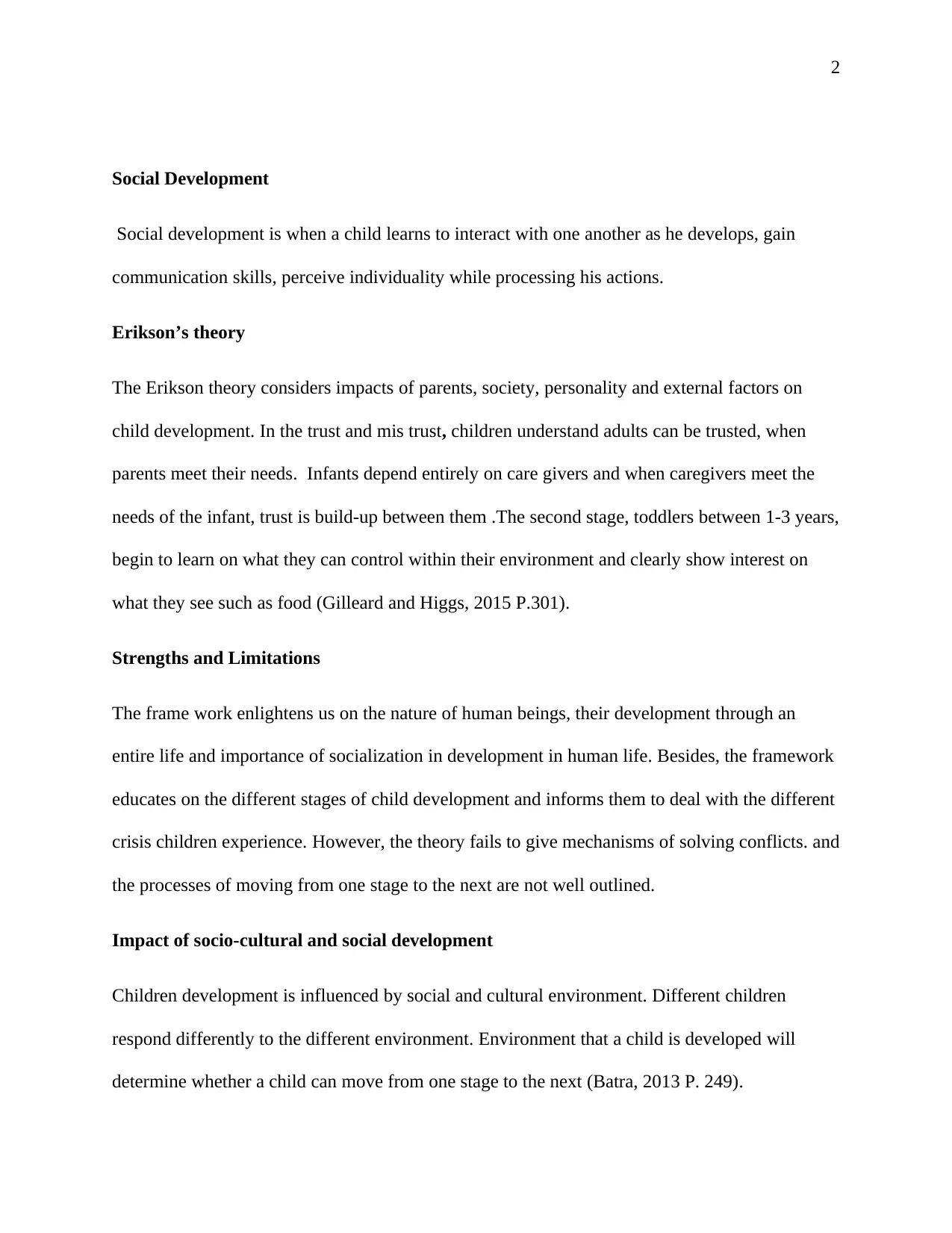
2
Social Development
Social development is when a child learns to interact with one another as he develops, gain
communication skills, perceive individuality while processing his actions.
Erikson’s theory
The Erikson theory considers impacts of parents, society, personality and external factors on
child development. In the trust and mis trust, children understand adults can be trusted, when
parents meet their needs. Infants depend entirely on care givers and when caregivers meet the
needs of the infant, trust is build-up between them .The second stage, toddlers between 1-3 years,
begin to learn on what they can control within their environment and clearly show interest on
what they see such as food (Gilleard and Higgs, 2015 P.301).
Strengths and Limitations
The frame work enlightens us on the nature of human beings, their development through an
entire life and importance of socialization in development in human life. Besides, the framework
educates on the different stages of child development and informs them to deal with the different
crisis children experience. However, the theory fails to give mechanisms of solving conflicts. and
the processes of moving from one stage to the next are not well outlined.
Impact of socio-cultural and social development
Children development is influenced by social and cultural environment. Different children
respond differently to the different environment. Environment that a child is developed will
determine whether a child can move from one stage to the next (Batra, 2013 P. 249).
Social Development
Social development is when a child learns to interact with one another as he develops, gain
communication skills, perceive individuality while processing his actions.
Erikson’s theory
The Erikson theory considers impacts of parents, society, personality and external factors on
child development. In the trust and mis trust, children understand adults can be trusted, when
parents meet their needs. Infants depend entirely on care givers and when caregivers meet the
needs of the infant, trust is build-up between them .The second stage, toddlers between 1-3 years,
begin to learn on what they can control within their environment and clearly show interest on
what they see such as food (Gilleard and Higgs, 2015 P.301).
Strengths and Limitations
The frame work enlightens us on the nature of human beings, their development through an
entire life and importance of socialization in development in human life. Besides, the framework
educates on the different stages of child development and informs them to deal with the different
crisis children experience. However, the theory fails to give mechanisms of solving conflicts. and
the processes of moving from one stage to the next are not well outlined.
Impact of socio-cultural and social development
Children development is influenced by social and cultural environment. Different children
respond differently to the different environment. Environment that a child is developed will
determine whether a child can move from one stage to the next (Batra, 2013 P. 249).
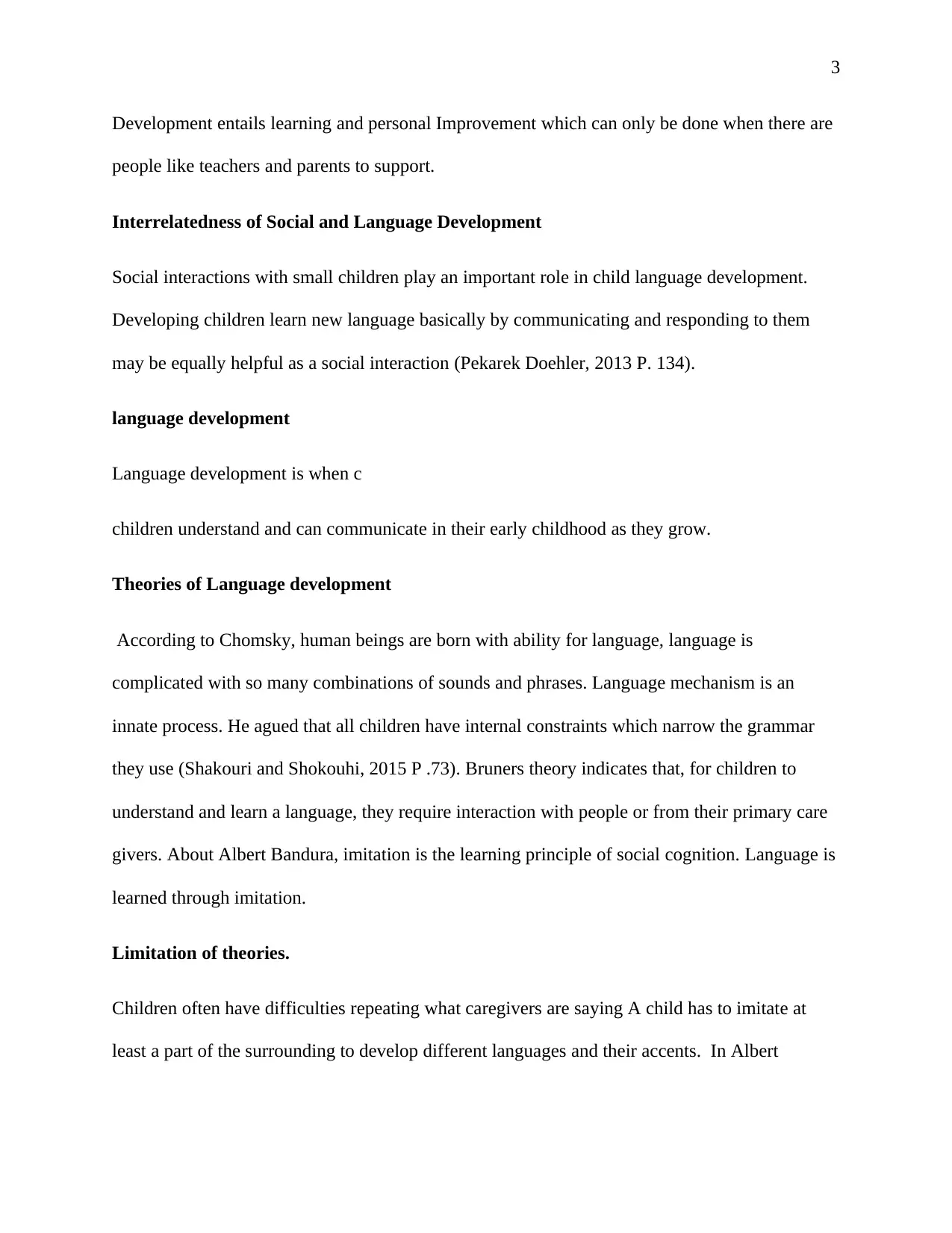
3
Development entails learning and personal Improvement which can only be done when there are
people like teachers and parents to support.
Interrelatedness of Social and Language Development
Social interactions with small children play an important role in child language development.
Developing children learn new language basically by communicating and responding to them
may be equally helpful as a social interaction (Pekarek Doehler, 2013 P. 134).
language development
Language development is when c
children understand and can communicate in their early childhood as they grow.
Theories of Language development
According to Chomsky, human beings are born with ability for language, language is
complicated with so many combinations of sounds and phrases. Language mechanism is an
innate process. He agued that all children have internal constraints which narrow the grammar
they use (Shakouri and Shokouhi, 2015 P .73). Bruners theory indicates that, for children to
understand and learn a language, they require interaction with people or from their primary care
givers. About Albert Bandura, imitation is the learning principle of social cognition. Language is
learned through imitation.
Limitation of theories.
Children often have difficulties repeating what caregivers are saying A child has to imitate at
least a part of the surrounding to develop different languages and their accents. In Albert
Development entails learning and personal Improvement which can only be done when there are
people like teachers and parents to support.
Interrelatedness of Social and Language Development
Social interactions with small children play an important role in child language development.
Developing children learn new language basically by communicating and responding to them
may be equally helpful as a social interaction (Pekarek Doehler, 2013 P. 134).
language development
Language development is when c
children understand and can communicate in their early childhood as they grow.
Theories of Language development
According to Chomsky, human beings are born with ability for language, language is
complicated with so many combinations of sounds and phrases. Language mechanism is an
innate process. He agued that all children have internal constraints which narrow the grammar
they use (Shakouri and Shokouhi, 2015 P .73). Bruners theory indicates that, for children to
understand and learn a language, they require interaction with people or from their primary care
givers. About Albert Bandura, imitation is the learning principle of social cognition. Language is
learned through imitation.
Limitation of theories.
Children often have difficulties repeating what caregivers are saying A child has to imitate at
least a part of the surrounding to develop different languages and their accents. In Albert
⊘ This is a preview!⊘
Do you want full access?
Subscribe today to unlock all pages.

Trusted by 1+ million students worldwide
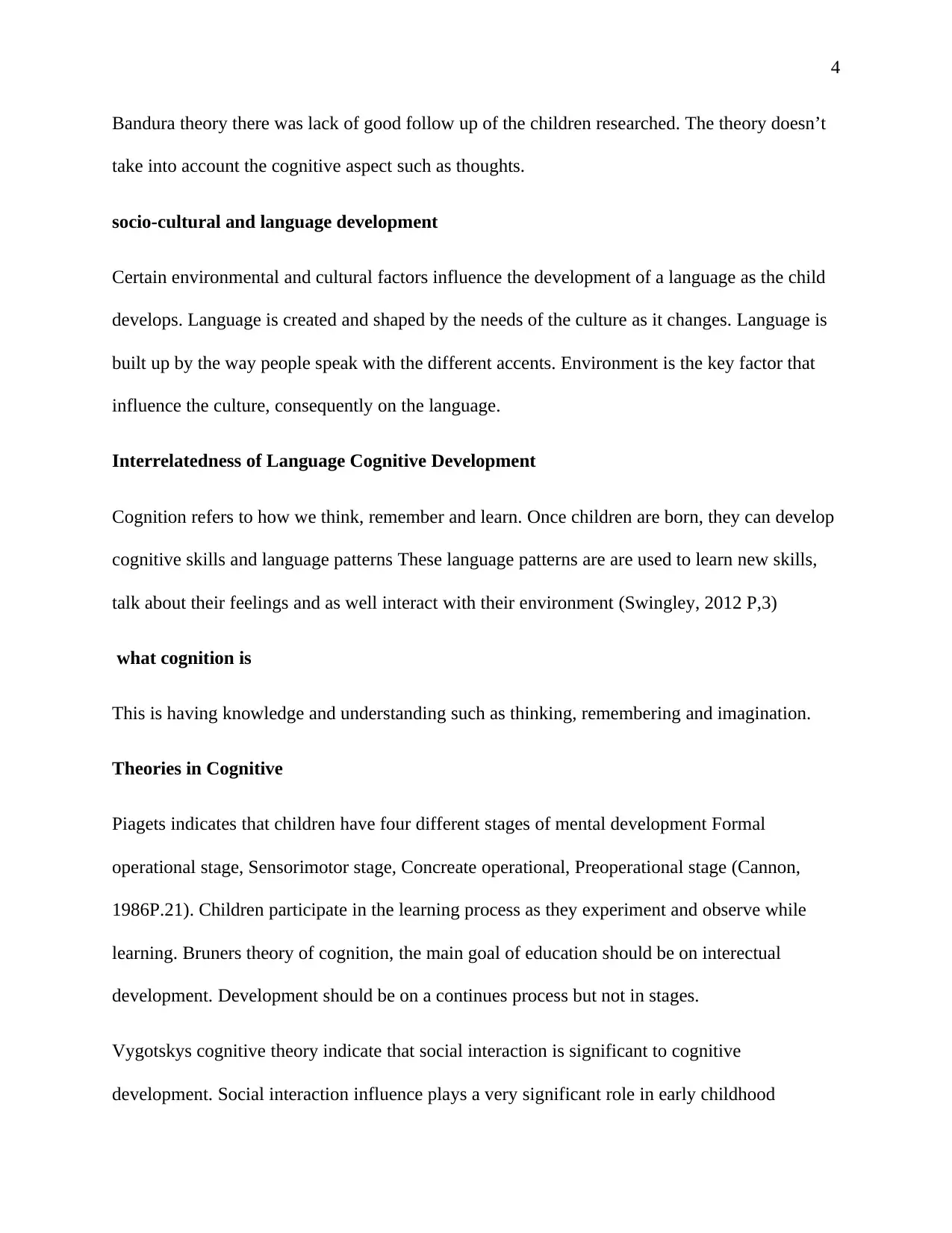
4
Bandura theory there was lack of good follow up of the children researched. The theory doesn’t
take into account the cognitive aspect such as thoughts.
socio-cultural and language development
Certain environmental and cultural factors influence the development of a language as the child
develops. Language is created and shaped by the needs of the culture as it changes. Language is
built up by the way people speak with the different accents. Environment is the key factor that
influence the culture, consequently on the language.
Interrelatedness of Language Cognitive Development
Cognition refers to how we think, remember and learn. Once children are born, they can develop
cognitive skills and language patterns These language patterns are are used to learn new skills,
talk about their feelings and as well interact with their environment (Swingley, 2012 P,3)
what cognition is
This is having knowledge and understanding such as thinking, remembering and imagination.
Theories in Cognitive
Piagets indicates that children have four different stages of mental development Formal
operational stage, Sensorimotor stage, Concreate operational, Preoperational stage (Cannon,
1986P.21). Children participate in the learning process as they experiment and observe while
learning. Bruners theory of cognition, the main goal of education should be on interectual
development. Development should be on a continues process but not in stages.
Vygotskys cognitive theory indicate that social interaction is significant to cognitive
development. Social interaction influence plays a very significant role in early childhood
Bandura theory there was lack of good follow up of the children researched. The theory doesn’t
take into account the cognitive aspect such as thoughts.
socio-cultural and language development
Certain environmental and cultural factors influence the development of a language as the child
develops. Language is created and shaped by the needs of the culture as it changes. Language is
built up by the way people speak with the different accents. Environment is the key factor that
influence the culture, consequently on the language.
Interrelatedness of Language Cognitive Development
Cognition refers to how we think, remember and learn. Once children are born, they can develop
cognitive skills and language patterns These language patterns are are used to learn new skills,
talk about their feelings and as well interact with their environment (Swingley, 2012 P,3)
what cognition is
This is having knowledge and understanding such as thinking, remembering and imagination.
Theories in Cognitive
Piagets indicates that children have four different stages of mental development Formal
operational stage, Sensorimotor stage, Concreate operational, Preoperational stage (Cannon,
1986P.21). Children participate in the learning process as they experiment and observe while
learning. Bruners theory of cognition, the main goal of education should be on interectual
development. Development should be on a continues process but not in stages.
Vygotskys cognitive theory indicate that social interaction is significant to cognitive
development. Social interaction influence plays a very significant role in early childhood
Paraphrase This Document
Need a fresh take? Get an instant paraphrase of this document with our AI Paraphraser
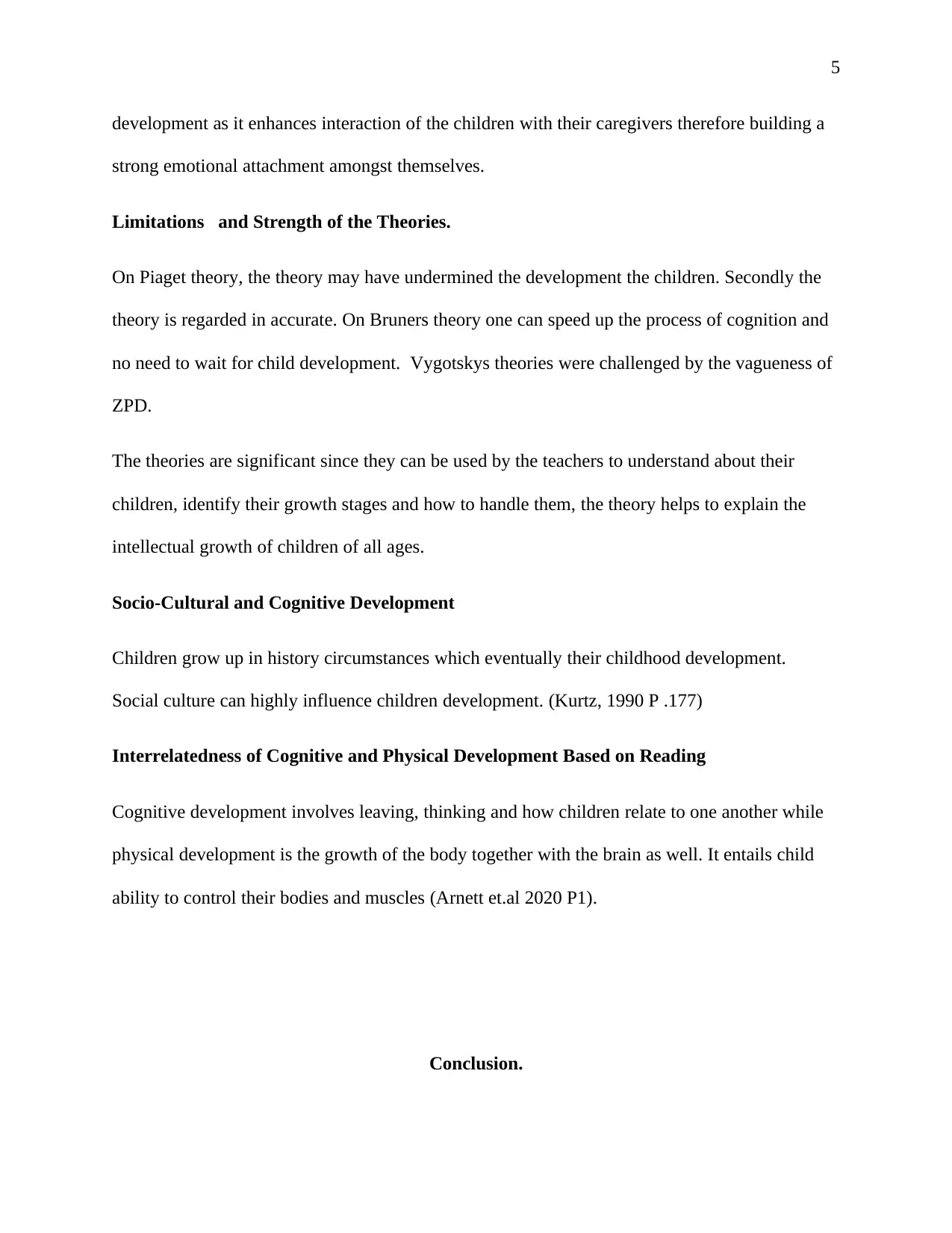
5
development as it enhances interaction of the children with their caregivers therefore building a
strong emotional attachment amongst themselves.
Limitations and Strength of the Theories.
On Piaget theory, the theory may have undermined the development the children. Secondly the
theory is regarded in accurate. On Bruners theory one can speed up the process of cognition and
no need to wait for child development. Vygotskys theories were challenged by the vagueness of
ZPD.
The theories are significant since they can be used by the teachers to understand about their
children, identify their growth stages and how to handle them, the theory helps to explain the
intellectual growth of children of all ages.
Socio-Cultural and Cognitive Development
Children grow up in history circumstances which eventually their childhood development.
Social culture can highly influence children development. (Kurtz, 1990 P .177)
Interrelatedness of Cognitive and Physical Development Based on Reading
Cognitive development involves leaving, thinking and how children relate to one another while
physical development is the growth of the body together with the brain as well. It entails child
ability to control their bodies and muscles (Arnett et.al 2020 P1).
Conclusion.
development as it enhances interaction of the children with their caregivers therefore building a
strong emotional attachment amongst themselves.
Limitations and Strength of the Theories.
On Piaget theory, the theory may have undermined the development the children. Secondly the
theory is regarded in accurate. On Bruners theory one can speed up the process of cognition and
no need to wait for child development. Vygotskys theories were challenged by the vagueness of
ZPD.
The theories are significant since they can be used by the teachers to understand about their
children, identify their growth stages and how to handle them, the theory helps to explain the
intellectual growth of children of all ages.
Socio-Cultural and Cognitive Development
Children grow up in history circumstances which eventually their childhood development.
Social culture can highly influence children development. (Kurtz, 1990 P .177)
Interrelatedness of Cognitive and Physical Development Based on Reading
Cognitive development involves leaving, thinking and how children relate to one another while
physical development is the growth of the body together with the brain as well. It entails child
ability to control their bodies and muscles (Arnett et.al 2020 P1).
Conclusion.
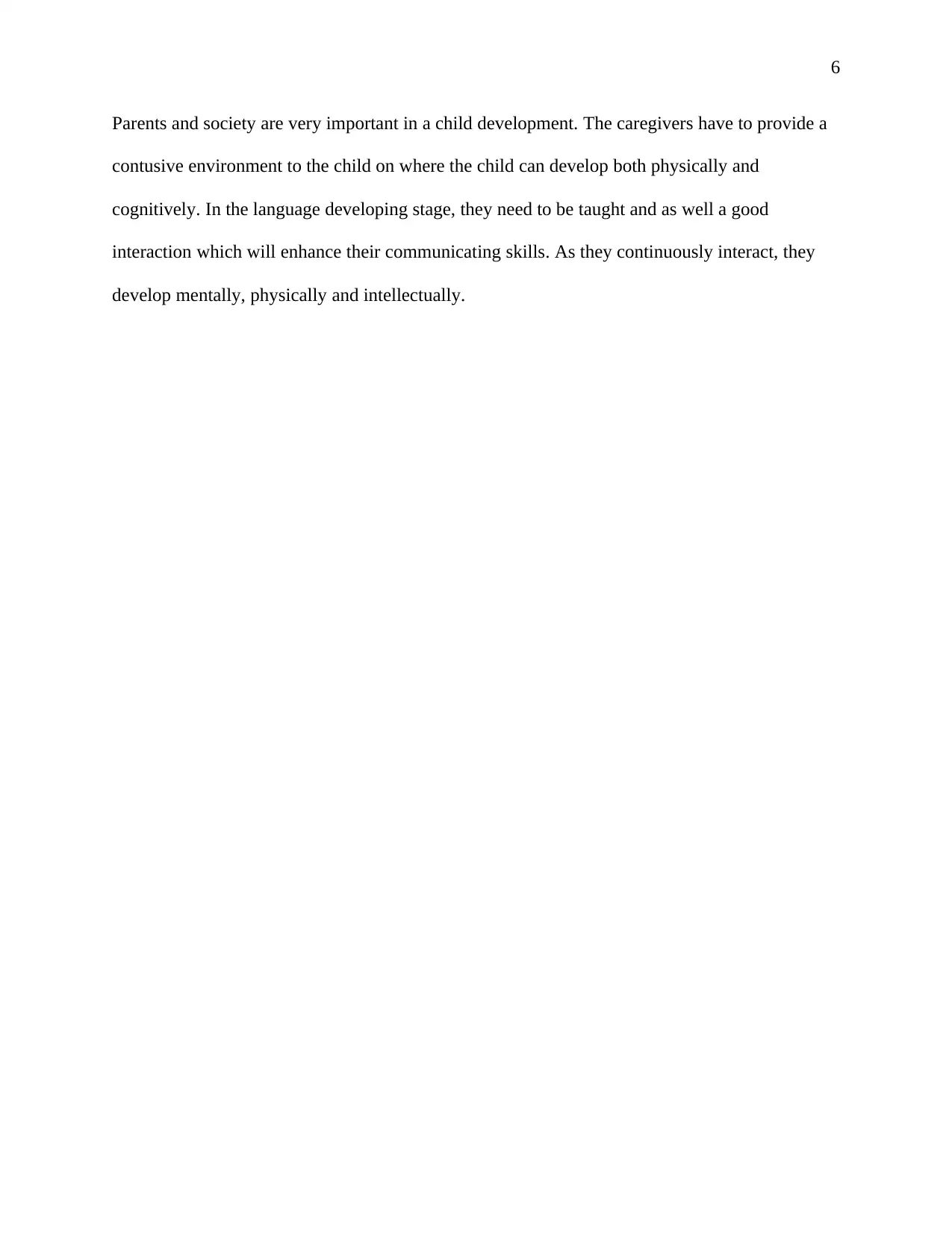
6
Parents and society are very important in a child development. The caregivers have to provide a
contusive environment to the child on where the child can develop both physically and
cognitively. In the language developing stage, they need to be taught and as well a good
interaction which will enhance their communicating skills. As they continuously interact, they
develop mentally, physically and intellectually.
Parents and society are very important in a child development. The caregivers have to provide a
contusive environment to the child on where the child can develop both physically and
cognitively. In the language developing stage, they need to be taught and as well a good
interaction which will enhance their communicating skills. As they continuously interact, they
develop mentally, physically and intellectually.
⊘ This is a preview!⊘
Do you want full access?
Subscribe today to unlock all pages.

Trusted by 1+ million students worldwide
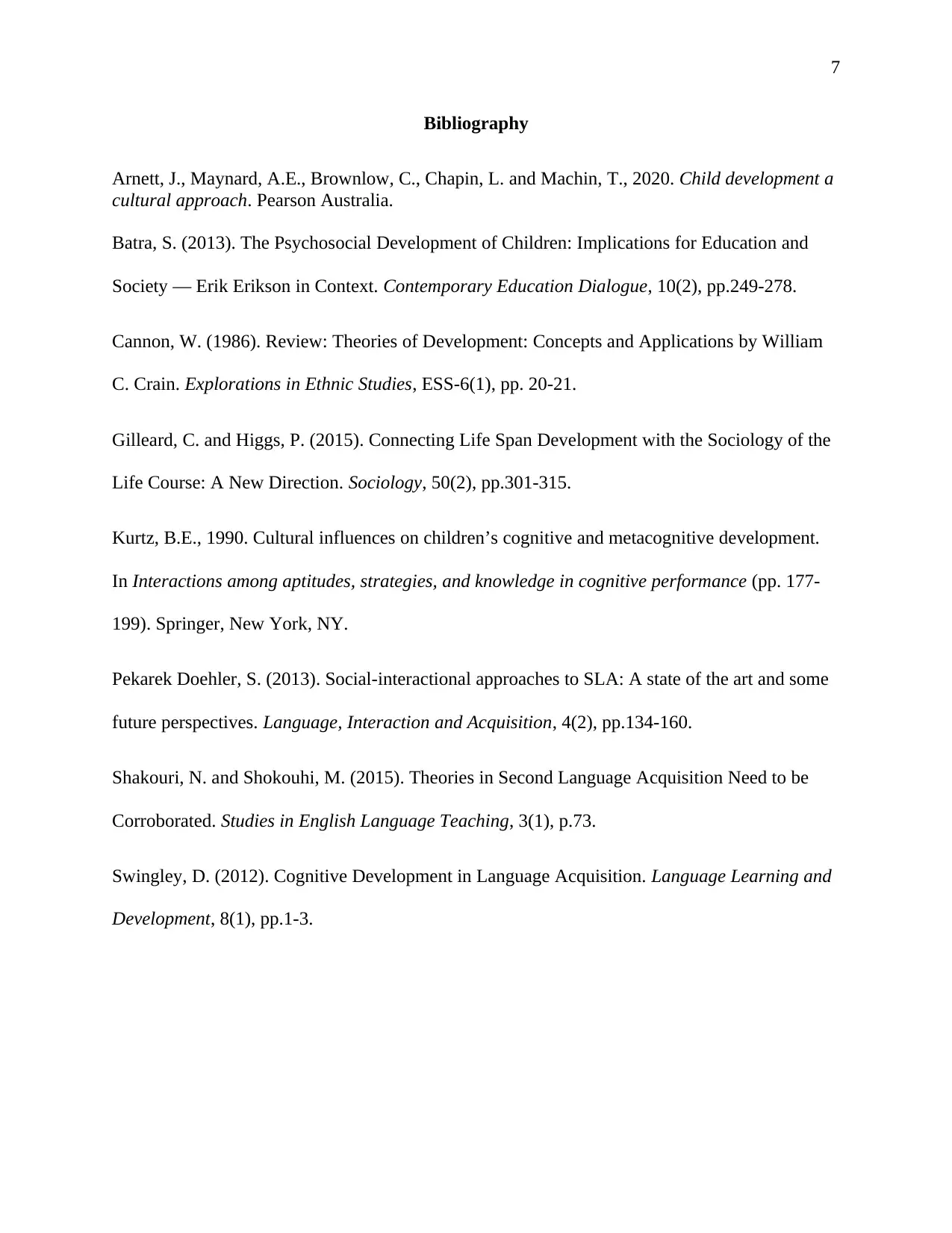
7
Bibliography
Arnett, J., Maynard, A.E., Brownlow, C., Chapin, L. and Machin, T., 2020. Child development a
cultural approach. Pearson Australia.
Batra, S. (2013). The Psychosocial Development of Children: Implications for Education and
Society — Erik Erikson in Context. Contemporary Education Dialogue, 10(2), pp.249-278.
Cannon, W. (1986). Review: Theories of Development: Concepts and Applications by William
C. Crain. Explorations in Ethnic Studies, ESS-6(1), pp. 20-21.
Gilleard, C. and Higgs, P. (2015). Connecting Life Span Development with the Sociology of the
Life Course: A New Direction. Sociology, 50(2), pp.301-315.
Kurtz, B.E., 1990. Cultural influences on children’s cognitive and metacognitive development.
In Interactions among aptitudes, strategies, and knowledge in cognitive performance (pp. 177-
199). Springer, New York, NY.
Pekarek Doehler, S. (2013). Social-interactional approaches to SLA: A state of the art and some
future perspectives. Language, Interaction and Acquisition, 4(2), pp.134-160.
Shakouri, N. and Shokouhi, M. (2015). Theories in Second Language Acquisition Need to be
Corroborated. Studies in English Language Teaching, 3(1), p.73.
Swingley, D. (2012). Cognitive Development in Language Acquisition. Language Learning and
Development, 8(1), pp.1-3.
Bibliography
Arnett, J., Maynard, A.E., Brownlow, C., Chapin, L. and Machin, T., 2020. Child development a
cultural approach. Pearson Australia.
Batra, S. (2013). The Psychosocial Development of Children: Implications for Education and
Society — Erik Erikson in Context. Contemporary Education Dialogue, 10(2), pp.249-278.
Cannon, W. (1986). Review: Theories of Development: Concepts and Applications by William
C. Crain. Explorations in Ethnic Studies, ESS-6(1), pp. 20-21.
Gilleard, C. and Higgs, P. (2015). Connecting Life Span Development with the Sociology of the
Life Course: A New Direction. Sociology, 50(2), pp.301-315.
Kurtz, B.E., 1990. Cultural influences on children’s cognitive and metacognitive development.
In Interactions among aptitudes, strategies, and knowledge in cognitive performance (pp. 177-
199). Springer, New York, NY.
Pekarek Doehler, S. (2013). Social-interactional approaches to SLA: A state of the art and some
future perspectives. Language, Interaction and Acquisition, 4(2), pp.134-160.
Shakouri, N. and Shokouhi, M. (2015). Theories in Second Language Acquisition Need to be
Corroborated. Studies in English Language Teaching, 3(1), p.73.
Swingley, D. (2012). Cognitive Development in Language Acquisition. Language Learning and
Development, 8(1), pp.1-3.
1 out of 7
Related Documents
Your All-in-One AI-Powered Toolkit for Academic Success.
+13062052269
info@desklib.com
Available 24*7 on WhatsApp / Email
![[object Object]](/_next/static/media/star-bottom.7253800d.svg)
Unlock your academic potential
Copyright © 2020–2025 A2Z Services. All Rights Reserved. Developed and managed by ZUCOL.





